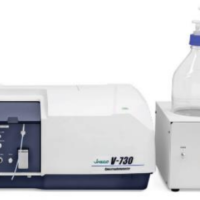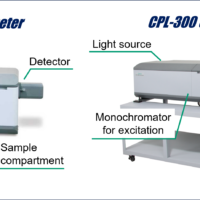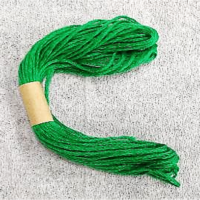Absorption spectrophotometer
A UV-vis spectrophotometer comprises a light source, a monochromator, a sample cuvette (cell), and a photodetector. There are two types of optical arrangement: single beam and double beam (Fig. 4). In either case, white light from a light source (LS) is introduced into a monochromator and dispersed by a diffraction grating. Only light with a specific wavelength is extracted from the resulting spectrum through the exit slit. In the case of a single beam, the obtained monochromatic light with intensity I0 irradiates a sample and the transmitted light with intensity I is detected. Here, I/I0 is the transmittance. In the double-beam configuration, the monochromatic light is divided into two by a beam splitter, and the individual beams pass through a sample and a reference, following which both are detected. By bifurcating the optical path, both I0 and I can be measured simultaneously.

Fig. 4 UV-vis spectrophotometer configuration (upper: single beam, lower: double beam)
Beer's law
Beer's law forms the basis of quantification using absorption spectroscopy. Here, the intensity of incident light in a sample cuvette is I0 and the intensity of transmitted light is I, and
I = I0 e -εC L
where C is the molar concentration of the solution, L is the thickness, and ε is the molar extinction coefficient
Taking the logarithm on both sides and transforming the formula,
-log (I / I0 ) = εCL
If the left side -log(I / I0) is defined as the absorbance A, then
A = εCL
That is, the absorbance A is proportional to the concentration C of the sample (Fig. 5). This equation is a calibration curve, and it can be used to accurately determine the concentration of unknown substances.

Fig. 5 Calibration curve for quantitative analysis
Photometric mode
The photometric modes (the vertical axis of the spectrum) used in UV-vis spectroscopy are:
Absorbance: Abs = log (I0 / I)
Transmittance: %T = I / I0 × 100
Reflectance: %R = I / I0 × 100
The experimental setup for transmission and reflection measurements is shown in Fig. 6.
When measuring a sample, Abs is used for quantitative analysis of factors such as concentration and turbidity, and %T and %R are used to determine factors such as the transmission/reflection characteristics, film thickness, and color.

Fig. 6 Transmission measurement (%T) and reflection measurement (%R)
Related Posts:
 Quantification Method for Oil and Grease in Water…
Quantification Method for Oil and Grease in Water… Quantitative Determination of Low-concentration…
Quantitative Determination of Low-concentration… Stability Evaluation of Trastuzumab and Rituximab…
Stability Evaluation of Trastuzumab and Rituximab… Stability Evaluation of Trastuzumab and Rituximab…
Stability Evaluation of Trastuzumab and Rituximab… Highly efficient spectral measurement methods using…
Highly efficient spectral measurement methods using… Base Material and Dye Analysis - Combined Raman and…
Base Material and Dye Analysis - Combined Raman and…
